Table of Contents
1
Experiencing the World of CCT
“Technology happens, it’s not good, it’s not bad.”
Andrew Grove
Co-founder of Intel Corporation
Objectives
After completing this Chapter, the student will be able to:
- identify the basic nature of computers and communication technology (CCT),
- explain the characteristics of CCT,
- describe applications of CCT at home, in education, and in other fields,
- appreciate the importance of CCT in real life applications,
- notice the changes brought about by CCT,
- perceive the problems of the digital divide and
- recognise major national organisations’ contributions to the development of CCT in India.
Introduction
With an abundance of electronic devices in general and, in particular, with a proliferation of computer-supported technologies and easy access to communication networks, the world today seems to begin with an e. It is e-mail, e-learning, e-business, e-content or even e-waste. In short, it is an e-world! Electronics is the dominant technology of our times.
From the wake–up alarm in the morning to the innumerable devices that we use throughout the day all machines are programmed. The programmable machine, the computer, affects almost everybody, in all walks of life. It connects people all over the world, without the distinctions of caste, creed, language and culture, supporting a communication network that was unimaginable before.
1.1 The World is changing with CCT
All over the world, there is a movement towards an information – based society. Therefore it seems extremely important that the basic nature and overall capabilities of CCT are understood and appreciated by all because computers are information processing tools and communication technologies enable us to share information. Together they affect all of us. It is also important that we are able to apply the technology tools in our work, whatever our field of work may be.
The way these technologies affect all of our lives include:
- Educational, in the way we learn and shape the course of our learning according to our own interests.
- Technological, in terms of knowledge creation, publishing and distribution.
- Societal, in our living, working and growing and looking at ourselves in a global context.
Today computers are seen as a personal accessory – portable, powerful and simple to operate. They can work in any place and connect us with anyone, any time (Figure 1.1). They are seen as an extension of the human hand and mind and are essential to every field of work.
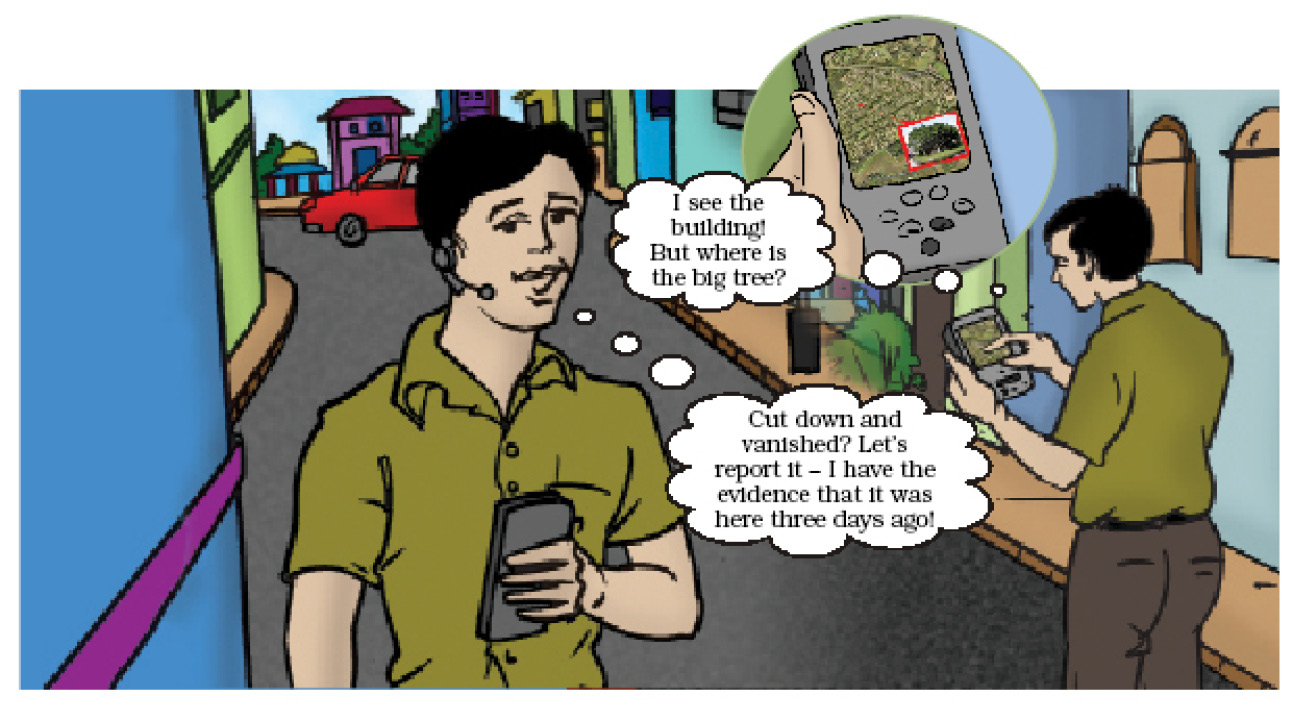
1.1.1 CCT in Homes
There are three different types of computers and computer applications that we encounter in daily life. One, those machines which are dedicated to a limited set of tasks. Familiar domestic appliances like washing machines or microwave oven are operated by an electronic device embedded inside these gadgets. Two, those that are used for specific and limited number of activities, like playing games and other forms of entertainment. The third category includes versatile machines capable of doing a multitude of tasks, including surfing the Internet.
In our day-to-day life, we use various electrical and electronic devices such as computers, digital watches, audio systems, CD and DVD players, washing machines and so on.
Outside home we use lifts, metro trains, coin collection systems in public telephone booths, coffee and tea vending machines and so on. These are mostly computer controlled devices. We do not see the ‘computers’; they are embedded inside these devices.
Computers have brought in changes in art and music, photography and animation, editing and publishing. Digital home theatre systems, DVD players, digital music devices of which the computer forms an integral part, makes entertainment low cost and of high quality. The Internet has emerged as a convenient means of global communication, information sharing and services. The commonest mode of the Internet use includes e-mail, chat, surfing information, banking, reservations and many more. A huge network of millions of computer networks constitutes the Internet. These networks are connected by telephones, underwater cables and satellites.
1.1.2 CCT in Education
Computers are widely used in schools, colleges and universities. They are used for computer-aided learning, distance education and administration. E-learning, training programmes and research are other areas of the educational field where computers are put to use.
When a physics teacher wants to show the different positions of a particle in a wave motion, a chemistry teacher wants to illustrate molecular collision or a biology teacher wants to show a beating heart, a mathematics teacher wants to show how a regular polygon approaches a circle when the number of sides tend to infinity or when an economist wants to illustrate an organic market and so on, a computer can effectively simulate these phenomena.
Conventional libraries can be computerised with library management software. It provides facilities to create a database of books, assign accession number, provide content wise, author wise searching facility, verify stock and issue notices. One could also go for digital libraries where books are available in an electronic format and are called e-books. In laboratories, computers are used as tools essential for various processes such as recording, analysing and plotting data for visual display.
From admission to examination, from staff management to parent interaction, from student information to public transaction, computers make possible automated management and administration of educational institutions. They are used for student enrollment, collection of fees, keeping attendance of student and staff, conducting examinations and announcing results. Besides this, all kinds of information about the organisation are available on the Net so that they can be accessed from anywhere.
Computers also make possible transaction of distance learning courses (often called e-learning). Computer programs or web tools provide step-wise learning. A student can decide the pace of learning for himself or herself. E-learning is flexible and convenient. A student can also attend e-classes. A teacher can supplement classroom instructions by encouraging self-learning of students through e-classes. Quality educational materials such as, online e-books, on line video-audio lectures, career guidance are available at the websites of many educational organisations and universities.
National Council of Educational Research and Training (NCERT), Indira Gandhi National Open University (IGNOU), National Institute of Open Schooling (NIOS) and Central Board of Secondary Education (CBSE) have their own websites which are accessed by thousands of visitors everyday.
National Council of Educational Research and Training
NCERT has its own website (Figure 1.2). Information about the organisation, its programmes and activities, school curriculum and syllabus, information on day-to-day activities of NCERT are available on the site. All NCERT textbooks, including this one (Computers and Communication Technology (CCT); Textbook for Class 11) are available online for reference purposes. Anyone can access these e-books and download from www.ncert.nic.in or www.ncert.gov.in.
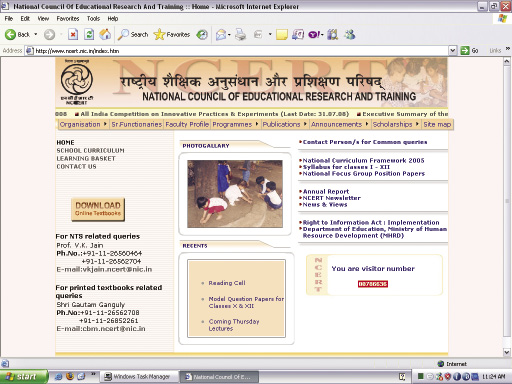
Figure 1.2 : NCERT’s website
Indira Gandhi National Open University
IGNOU offers distance education degree programmes in arts, science,
commerce, social sciences and information technology. It has democratised higher education by taking education to the doorstep of the learner. It provides educational opportunities to employed persons by offering need–based academic programmes.
The courses available are professional and vocational. Above all it is an apex body for setting and maintaining standards in distance education across the country (Figure 1.3).
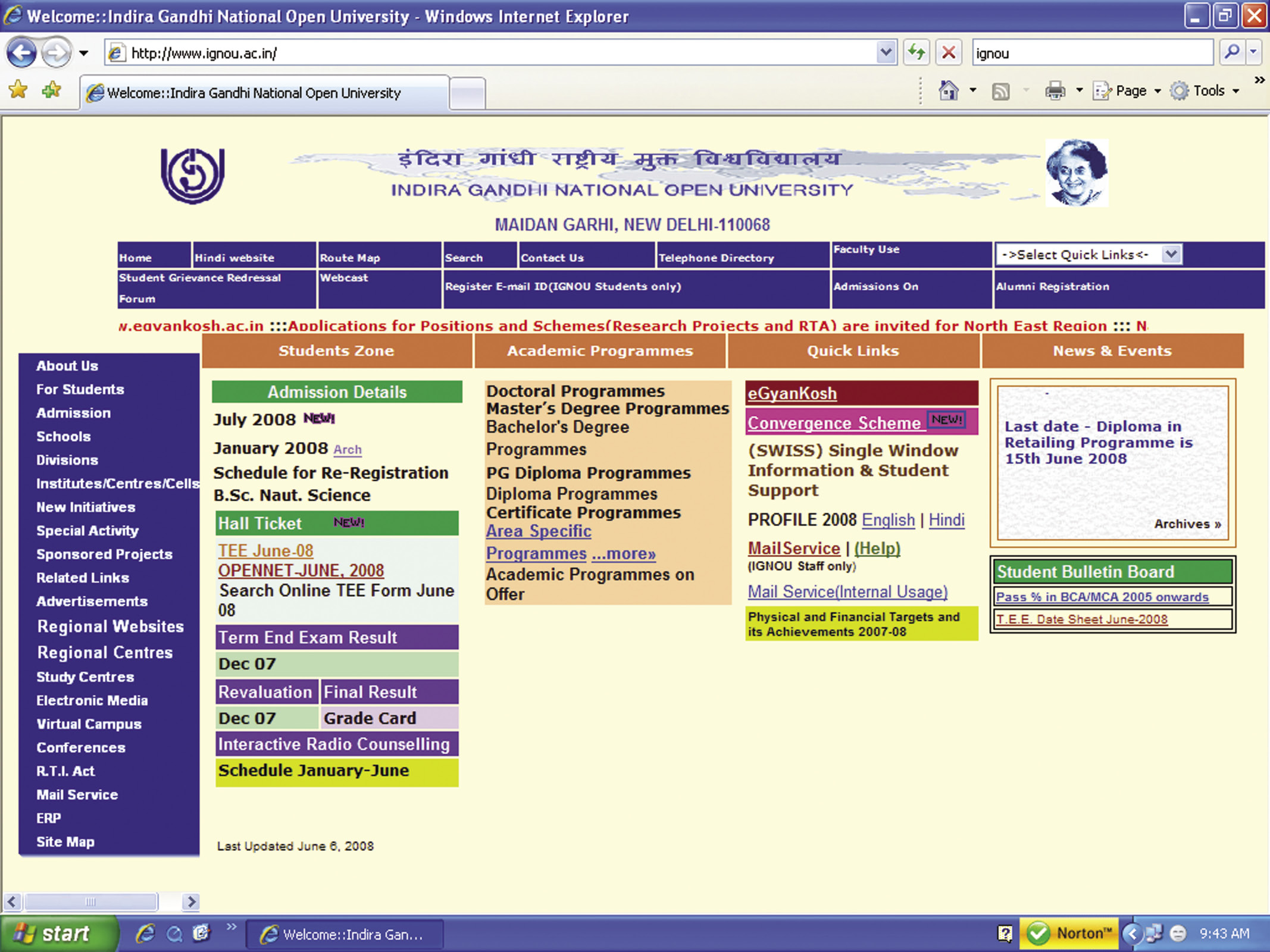
Figure 1.3 : IGNOU'S website
National Institute of Open Schooling
NIOS, which offers ‘sustainable and learner centric education,’ was established by the MHRD, Government of India as an autonomous organisation for open schooling in pursuance of National Policy on Education. In addition to the general and academic courses, NIOS offers a number of vocational and community oriented courses. The website of NIOS (Figure 1.4 ) can be accessed at www.nios.ac.in and www.nios.org.
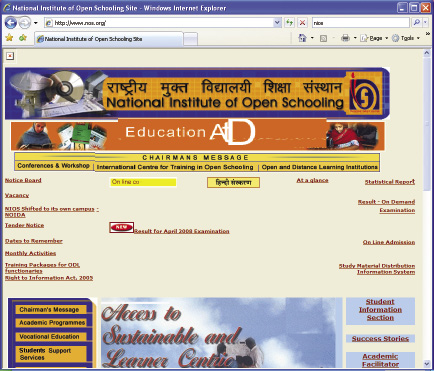
Figure 1.4 : Website of NIOS
Central Board of Secondary Education
CBSE has its own site at www.cbse.nic.in (Figure 1.5). This website provides information regarding admission, courses offered, syllabi, examination results and so on. Various forms like those for admission, rechecking of marks and other purposes can be downloaded from the website. You can fill and submit the forms online It saves time for students and their parents.
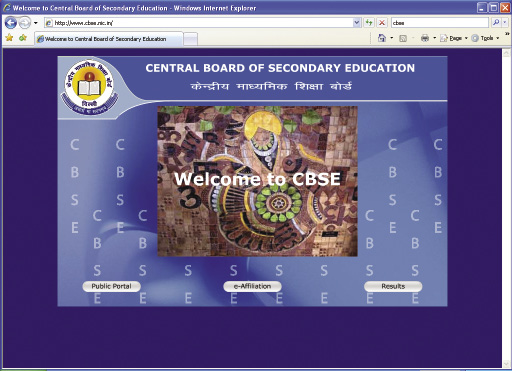
Figure 1.5 : CBSE’s website
The Ministry of Human Resource Development has designed an education portal* named ‘SAKSHAT’: One Stop Solution to Education’ (Figure 1.6). This portal caters to the needs of students, starting from elementary students to research, scholars, teachers and life long learners. The portal can be accessed at www.sakshat.ac.in.

*A portal is used to describe a website that acts as an entry point or gateway to a wide range of services or resources, usually including a search facility, directory of other sites, news, e-mail, etc.
Most universities and school boards conduct some online examinations. Compilation of results is computerised using refined statistical tools and facilitating accurate analysis on multiple parameters. The computerised list of candidates has students’ photos and finger print identities for computers to assist in detecting impersonation and other malpractices.
1.1.3 CCT in Public Life
CCT offers powerful means to make governance transparent and answerable to the people. Similarly, they can be used to ensure more transparency in business practices.
With CCT working in tandem with other factors that strengthen democracy, such as the Right to Information Bill, we can hope to see increased empowerment of ordinary citizens. CCT could eliminate the role of the intermediary who makes profit by keeping information secret and leaking it selectively to those who please them. Ultimately, CCT may help to balance the sharp socio-economic divides in our society by giving access to those who were kept away from the mainstream due to lack of relevant information.
1.2 CCT and the Digital Divide
From a relatively slow-changing, multi-structured society where many disparities co-existed, India is now passing through a period of transition. At such times there is a lot of pressure on society to become homogeneous. That is when the inequities between different sections become all the more evident.
One such inequality, called the digital divide, separates those who have access to the digital world (computers and related technologies) from those who do not have this access. While one section of young people may have access to CCT at home, at school and in their mobile phones, the majority may get a chance to experience CCT only occasionally. It is obvious that the ones with the advantage will keep up with the technological growth while the others would keep falling further behind in terms of information access.
This divide could cause strain, even conflict, in society. However, the tension can be eased:
- if everyone knows what they can get out of CCT,
- if we can cut the costs of access,
- if there are enough public Internet facilities available, and
- if enough sites in Indian languages come up.
We may see a great knowledge revolution in our own lifetime. Access to the global network in particular and acquaintance with communication network may help us realise a new kind of freedom – to think independently, collaborate with others to solve common problems, to realise what we want and need for ourselves and not what uptill now someone else thought was good for us.
1.3 CCT and E-Commerce
E-commerce employs computers in different areas of commerce such as marketing, customer visit, product browsing, shopping basket checkout, tax and shopping, receipt and process order while e-business offers services pertaining to processing transactions, documentation, presentations, financial analysis, home based services, inventory management and gathering product information using CCT.
All leading banks, including the State Bank of India (Figure 1.7) provide Internet banking facility. With this facility one can check account balance and perform bank transactions from anywhere. We can see account details, pay a bill and print account statement online. Also, the bank provides SMS alert service, so that, whenever bank transaction takes place, an SMS is sent by the bank to our mobile phones.

Figure 1.7 : Web Portal of State Bank of India
The digital nature of CCT results in convergence.
Text, photos, statistical tables, maps, music, movies are all produced digitally, in that they are coded and made up of zeros and ones. This makes it convenient to bring them together onto common platforms. They can be brought into play, interchanged and transformed, and also circulated digitally.
1.4 Major National Organisations Working in the Area of CCT
1.4.1 National Informatics Centre (NIC)
National Informatics Centre (Figure 1.8) of the Department of Information Technology is providing network backbone and e-governance support to Central and State Governments, Union Territories administrations, districts and other government bodies in India. It offers a wide range of ICT services including Nationwide Communication Network for decentralised planning, improvement in government services and wider transparency in national and local governments. NIC assists in implementing Information Technology Projects and is also responsible for bringing computerisation in the lives of the Indian people.
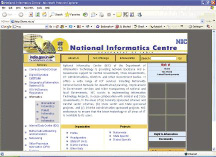
Figure 1.8 : NIC’s website (www.home.nic.in)
1.4.2 National Association of Software and Services Companies AS(NSCOM)
NASSCOM (Figure 1.9) is the premier trade body and the chamber of commerce of the IT-BPO industry in India. It is a global trade body with more than 1200 members who are broadly in the business of services, products, IT infrastructure management, R&D services, e-commerce and web services, engineering services, offshoring, and animation and gaming.
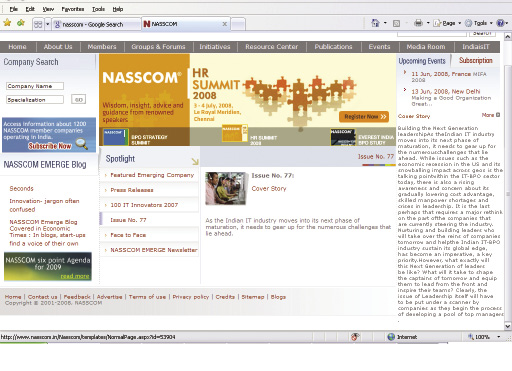
Figure 1.9 : NASSCOM’s website (http://www.nasscom.in)
1.4.3 Department of Information Technology
Department of Information Technology (Figure 1.10) is under the Ministry of Communications and Information Technology, Government of India. Its main objective is to make India a global information technology super power and a front-runner in the age of information revolution, to bring the benefits of electronics to every walk of life and to develop the Indian electronics industry as a global player. Its website has an important portal, viz., The India Portal (www.india.gov.in), v‘single window access’ to information and government to consumer services to be electronically delivered from all state sector institutions and organisations. It provides multilingual content and had received the Best e-Governance Award in Technology at the national level announced by the Computer Society of India (CSI) in 2006.
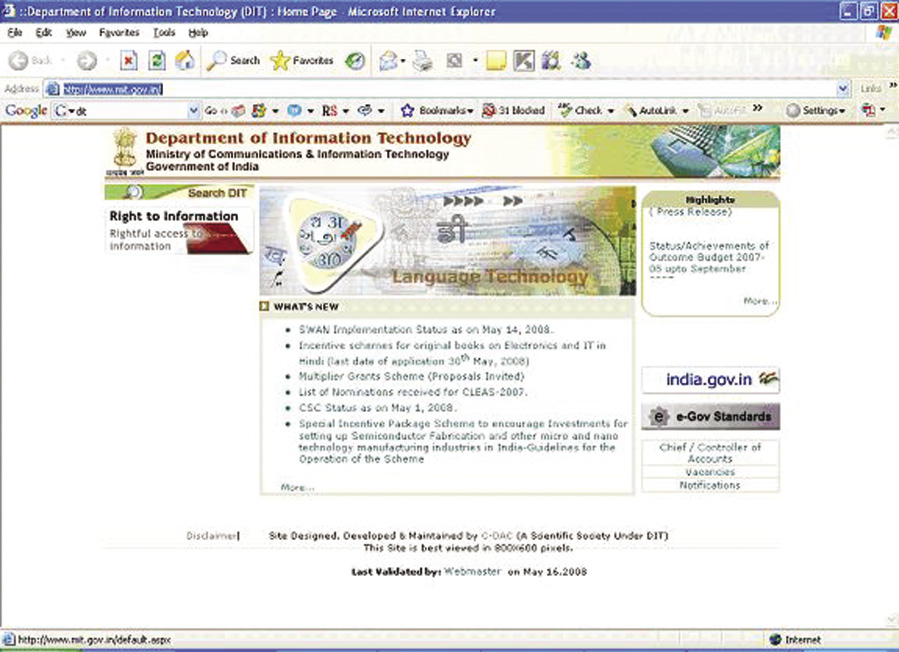
Summary
- Powerful technology is within our reach.
- It has overpowered the limitations of time, distance and money.
- CCT links people all over irrespective of distances between them.
- CCT has changed our life pattern.
- Computers have been useful at home as appliances, supporting entertainment/games and for surfing the Internet.
- CCT are capable of contributing a lot to education, buiseness, e-governance, etc.
- Easier access to CCT can help bridge the digital divide.
Exercises
1. List some other uses of computers at home which are not mentioned in this chapter.
2. List different activities performed by a corporate house using computers.
3. Visit any nearby industry and list the use of computers there.
4. List the advantages of computer usage in an industry.
5. List the advantages of computers in commerce.
6. Observe your school carefully and list different departments where computers are used. Also, state the purpose for which they are used.
7. List the advantages of a digital library.
8. Check which library management software is used by your school ?
9. List the advantages and disadvantages of e-learning.
10. List the advantages of using computers in design and drawing.
References
Websites
1. www.mit.gov.in
2. www.home.nic.in
3. www.wikipedia.org
4. www.encyclopedia.com
5. www.onelook.com
Education
1. www.ncert.nic.in and www.ncert.gov.in
2. www.sakshat.ac.in
3. www.ignou.ac.in
4. www.cbse.nic.in
5. www.nios.ac.in
6. www.education.nic.in
Internet Banking
1. www.onlinesbi.com
Travel Planning
1. www. Indianrailways.gov.in
2. www.india-airlines.nic.in
3. www.yatra.com
4. www.makemytrip.com
Searching
1. www.google.com
2. www.search.yahoo.com
Physics
1. www.jhuapl.edu
2. www.ioffe.rssi.ru
3. www.fzu.cz
4. www.nplindia.org